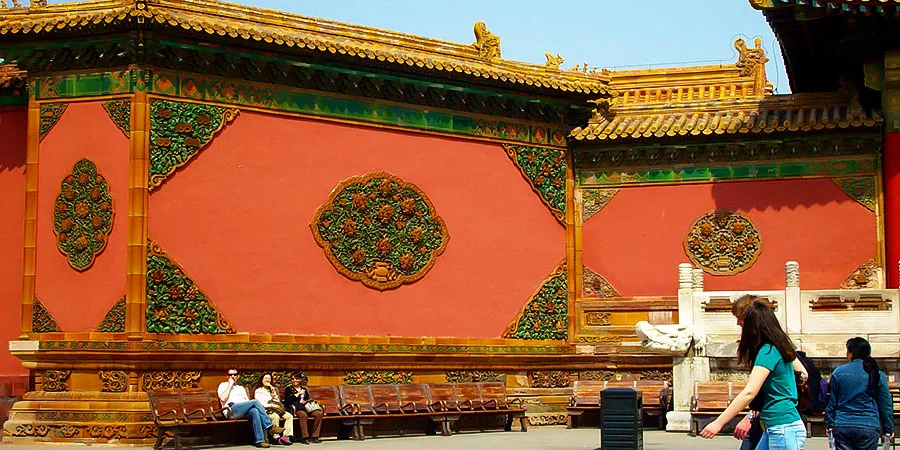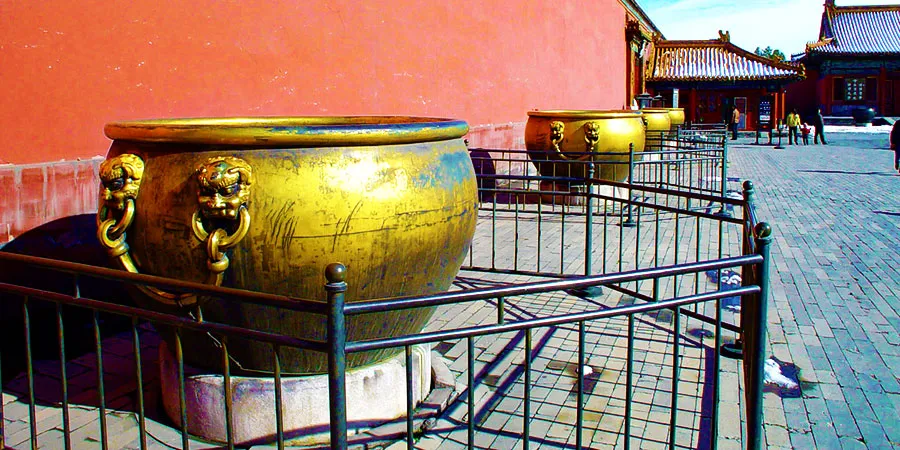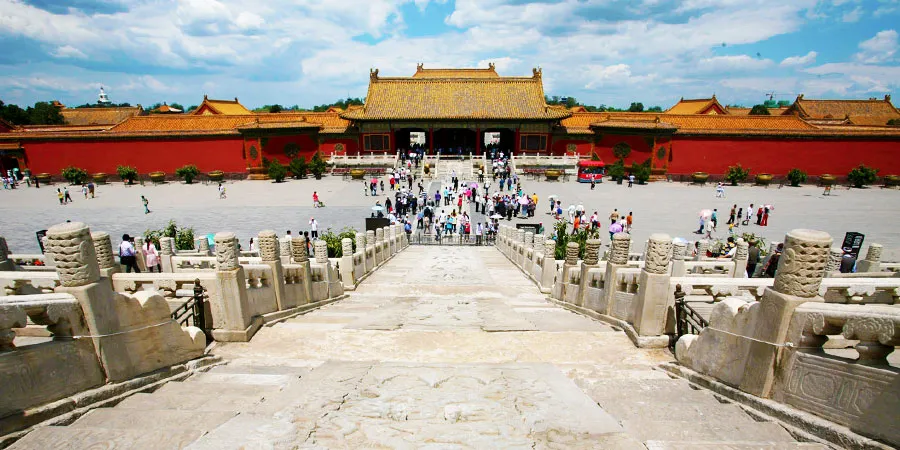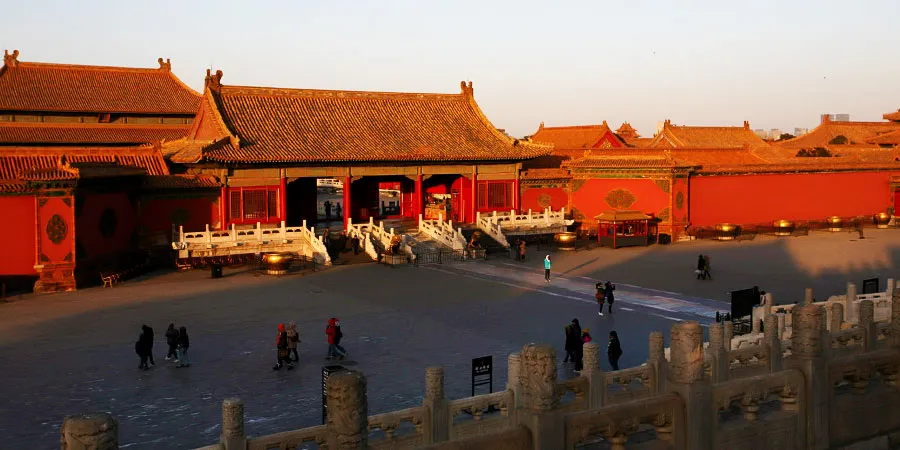Gate of Heavenly Purity (Qianqingmen)
Also named Gate of Celestial Purity or Qianqingmen, the Gate of Heavenly Purity is on the central axis divides the Forbidden City into two parts, the Outer Court and the Inner Court, therefore, serving as the main entrance to the imperial household. This gate was also a pivotal location where the Qing dynasty emperors held daily governmental courts.
About 27.5 meters (90 feet) wide, 16.5 meters (54 feet) deep and 16 meters (52.5 feet) high, it is a structure with single-eaved roof, resting on the 1.5-meter-high (5 feet) white marble base of Buddhist-style building surrounded by carved stone balustrades.
In front of the gate, two gold-plated bronze lions with drooping ears and eyes stand guard, while inverted V-shaped glazed tile screens flank both sides, which are the unique highlights of the gate.
 Why are the lions floppy-eared and squinting?
Why are the lions floppy-eared and squinting?
About 27.5 meters (90 feet) wide, 16.5 meters (54 feet) deep and 16 meters (52.5 feet) high, it is a structure with single-eaved roof, resting on the 1.5-meter-high (5 feet) white marble base of Buddhist-style building surrounded by carved stone balustrades.
In front of the gate, two gold-plated bronze lions with drooping ears and eyes stand guard, while inverted V-shaped glazed tile screens flank both sides, which are the unique highlights of the gate.
 |
| Gate of Heavenly Purity |
Unmissable Outer Decorations of Gate of Heavenly Purity
Droopy-eared Bronze Lions with Half-open Eyes
 |
| Lion Statues in front of Gate of Heavenly Purity |
As is known, the Forbidden City holds numerous bronze lions, but the pair squatting in front of this gate are somehow different. Sharp eyes will spot that the ears and eyes of these two lions are flipperty-flopperty while other lion statues inside the Forbidden City with their ears perked up and eyes opened up.
The palace behind the Gate was where the emperor and his concubines lived. The droopy ears and squinting eyes were meant to convey the message that the concubines should keep their eyes and ears closed to the affairs of state, which were the domain of the emperor and his male courtiers.
V-shaped Glazed Screen Walls
 |
Standing in front of the Gate of Heavenly Purity, you'll notice a narrow square of just 50 meters (164 feet) from north to south. The flanking V-shaped glazed screen walls stretch about 9.7 meters (32 feet), creating a 120-degree embrace with the gate in the center, extending the visual width and emphasizing its role as the grand entrance to the inner court.
In addition, the 8-meter-tall (26 feet) glazed screen walls, adorned with exquisite floral patterns in yellow, green, and blue, break up the monotony of red palace walls and add a splash of color to the space.
Plus, the screen walls act as a natural divider, enhancing the separation between the inner and outer courts.
Gild Bronze Vats
 |
Outside the gate there are four huge gleaming, gilded bronze vats. Their prime function was to hold vast amount of water to fight the outbreak of fire. Each of these vats weighs four tons and would contain over 3,000 liters (about 793 gallons) of water. Three hundred and eight vats spread around the Forbidden City, twenty-two of which are of the same design as those seen here.
Functions of Gate of Heavenly Purity
Core Division of Outer & Inner Court of Forbidden City
 |
The Gate of Heavenly Purity and its front Qianqingmen Square served as a clear dividing line between the Outer Court, where state affairs were conducted, and the Inner Court, the private residence of the emperor and his concubines. This architectural design intended to show that the emperor could handle state matters in the Outer Court with impartiality, without allowing personal considerations to influence his decisions.
Imperial Audience for Governance
 |
Shunzhi, the first emperor of the Qing Dynasty reigning from 1644 to 1661, started to use the Gate of Heavenly Purity as the venue for governmental issues. For example, he issued the Bill of Oblivion in an audience at this gate in 1644. During the following period of the Qing Dynasty, some emperors held court here.
Ministers and officials would gather here at dawn waiting for the emperor to come. A throne was set and the emperor would sit here to listen to memorandums presented to him by the kneeling ministers in the order of those in charge of the boards of Revenue, Rites, War, Works and Civil Office. Decisions would be made by the emperor.
Emperor Kangxi, ruling for an impressive 61 years from 1662 to 1722, frequently held imperial audiences at the Gate of Heavenly Purity for governance. On average, he spent 20 days a year here, making him the most diligent Qing emperor.
When Built – History of Gate of Heavenly Purity
The Gate of Heavenly Purity, originally constructed in 1420 during the Ming Dynasty and renovated in 1655 during the Qing Dynasty, retains its Ming-era basic structure and layout. Some decorations, such as the gilded bronze lions, are relics from the Qing Dynasty.
![]() Next:
Next:
Go further north to see the three grand halls of the Inner Court:![]() Palace of Heavenly Purity (Qianqinggong)
Palace of Heavenly Purity (Qianqinggong)![]() Hall of Celestrial and Terrestial Union (Jiaotaidian)
Hall of Celestrial and Terrestial Union (Jiaotaidian)![]() Palace of Earthly Tranquility (Kunninggong)
Palace of Earthly Tranquility (Kunninggong)
One can also see the Palace of Abstinence (Zhaigong) on the east, and the Hall of Mental Cultivation (Yangxindian) on the west.
If time permits, before entering the Gate of Heavenly Purity, one can turn east to see the Hall for Ancestry Worship (Fengxiandian), or turn west to explore the Palace of Compassion and Tranquility (Cininggong).![]() Further Reading:
Further Reading:
How to visit the Forbidden City
Ancient Alarm System in the Forbidden City
Interesting Animal Statues in the Forbidden City
- Last updated on Apr. 29, 2025 by Jally Zhang -